+ データを開く
データを開く
- 基本情報
基本情報
| 登録情報 | データベース: PDB / ID: 2xkx | ||||||
|---|---|---|---|---|---|---|---|
| タイトル | Single particle analysis of PSD-95 in negative stain | ||||||
 要素 要素 | DISKS LARGE HOMOLOG 4 | ||||||
 キーワード キーワード | STRUCTURAL PROTEIN / SCAFFOLD PROTEIN / MEMBRANE ASSOCIATED GUANYLATE KINASE | ||||||
| 機能・相同性 |  機能・相同性情報 機能・相同性情報RHO GTPases activate CIT / positive regulation of AMPA glutamate receptor clustering / neuronal ion channel clustering / P2Y1 nucleotide receptor binding / Neurexins and neuroligins / beta-1 adrenergic receptor binding / embryo development / neuroligin family protein binding / structural constituent of postsynaptic density / proximal dendrite ...RHO GTPases activate CIT / positive regulation of AMPA glutamate receptor clustering / neuronal ion channel clustering / P2Y1 nucleotide receptor binding / Neurexins and neuroligins / beta-1 adrenergic receptor binding / embryo development / neuroligin family protein binding / structural constituent of postsynaptic density / proximal dendrite / positive regulation of neuron projection arborization / regulation of grooming behavior / synaptic vesicle maturation / receptor localization to synapse / cellular response to potassium ion / protein localization to synapse / cerebellar mossy fiber / vocalization behavior / LGI-ADAM interactions / Trafficking of AMPA receptors / neuron spine / dendritic branch / Activation of Ca-permeable Kainate Receptor / AMPA glutamate receptor clustering / frizzled binding / dendritic spine morphogenesis / juxtaparanode region of axon / negative regulation of receptor internalization / dendritic spine organization / neuron projection terminus / acetylcholine receptor binding / establishment or maintenance of epithelial cell apical/basal polarity / postsynaptic neurotransmitter receptor diffusion trapping / positive regulation of synapse assembly / regulation of NMDA receptor activity / Synaptic adhesion-like molecules / positive regulation of dendrite morphogenesis / RAF/MAP kinase cascade / neurotransmitter receptor localization to postsynaptic specialization membrane / cortical cytoskeleton / locomotory exploration behavior / regulation of neuronal synaptic plasticity / kinesin binding / positive regulation of excitatory postsynaptic potential / social behavior / AMPA glutamate receptor complex / neuromuscular process controlling balance / positive regulation of protein tyrosine kinase activity / excitatory synapse / D1 dopamine receptor binding / Unblocking of NMDA receptors, glutamate binding and activation / positive regulation of synaptic transmission / glutamate receptor binding / beta-2 adrenergic receptor binding / extrinsic component of cytoplasmic side of plasma membrane / dendrite cytoplasm / synaptic membrane / cell periphery / PDZ domain binding / postsynaptic density membrane / regulation of long-term neuronal synaptic plasticity / ionotropic glutamate receptor binding / establishment of protein localization / neuromuscular junction / cerebral cortex development / kinase binding / cell-cell adhesion / cell-cell junction / synaptic vesicle / cell junction / positive regulation of cytosolic calcium ion concentration / scaffold protein binding / postsynapse / protein-containing complex assembly / basolateral plasma membrane / chemical synaptic transmission / protein phosphatase binding / postsynaptic membrane / dendritic spine / postsynaptic density / neuron projection / signaling receptor binding / glutamatergic synapse / synapse / dendrite / protein-containing complex binding / protein kinase binding / endoplasmic reticulum / membrane / plasma membrane / cytoplasm / cytosol 類似検索 - 分子機能 | ||||||
| 生物種 |  | ||||||
| 手法 | 電子顕微鏡法 /  溶液散乱 / 単粒子再構成法 / ネガティブ染色法 / 解像度: 22.9 Å 溶液散乱 / 単粒子再構成法 / ネガティブ染色法 / 解像度: 22.9 Å | ||||||
| Model type details | CA ATOMS ONLY, CHAIN A, B | ||||||
 データ登録者 データ登録者 | Fomina, S. / Howard, T.D. / Sleator, O.K. / Golovanova, M. / O'Ryan, L. / Leyland, M.L. / Grossmann, J.G. / Collins, R.F. / Prince, S.M. | ||||||
 引用 引用 |  ジャーナル: Biochim Biophys Acta / 年: 2011 ジャーナル: Biochim Biophys Acta / 年: 2011タイトル: Self-directed assembly and clustering of the cytoplasmic domains of inwardly rectifying Kir2.1 potassium channels on association with PSD-95. 著者: Svetlana Fomina / Tina D Howard / Olivia K Sleator / Marina Golovanova / Liam O'Ryan / Mark L Leyland / J Günter Grossmann / Richard F Collins / Stephen M Prince /  要旨: The interaction of the extra-membranous domain of tetrameric inwardly rectifying Kir2.1 ion channels (Kir2.1NC(4)) with the membrane associated guanylate kinase protein PSD-95 has been studied using ...The interaction of the extra-membranous domain of tetrameric inwardly rectifying Kir2.1 ion channels (Kir2.1NC(4)) with the membrane associated guanylate kinase protein PSD-95 has been studied using Transmission Electron Microscopy in negative stain. Three types of complexes were observed in electron micrographs corresponding to a 1:1 complex, a large self-enclosed tetrad complex and extended chains of linked channel domains. Using models derived from small angle X-ray scattering experiments in which high resolution structures from X-ray crystallographic and Nuclear Magnetic Resonance studies are positioned, the envelopes from single particle analysis can be resolved as a Kir2.1NC(4):PSD-95 complex and a tetrad of this unit (Kir2.1NC(4):PSD-95)(4). The tetrad complex shows the close association of the Kir2.1 cytoplasmic domains and the influence of PSD-95 mediated self-assembly on the clustering of these channels. #1:  ジャーナル: J Mol Biol / 年: 2003 ジャーナル: J Mol Biol / 年: 2003タイトル: Supramodular structure and synergistic target binding of the N-terminal tandem PDZ domains of PSD-95. 著者: Jia-Fu Long / Hidehito Tochio / Ping Wang / Jing-Song Fan / Carlo Sala / Martin Niethammer / Morgan Sheng / Mingjie Zhang /  要旨: PDZ domain proteins play critical roles in binding, clustering and subcellular targeting of membrane receptors and ion channels. PDZ domains in multi-PDZ proteins often are arranged in groups with ...PDZ domain proteins play critical roles in binding, clustering and subcellular targeting of membrane receptors and ion channels. PDZ domains in multi-PDZ proteins often are arranged in groups with highly conserved spacing and intervening sequences; however, the functional significance of such tandem arrangements of PDZs is unclear. We have solved the three-dimensional structure of the first two PDZ domains of postsynaptic density protein-95 (PSD-95 PDZ1 and PDZ2), which are closely linked to each other in the PSD-95 family of scaffold proteins. The two PDZs have limited freedom of rotation and their C-terminal peptide-binding grooves are aligned with each other with an orientation preference for binding to pairs of C termini extending in the same direction. Increasing the spacing between PDZ1 and PDZ2 resulted in decreased binding between PDZ12 and its dimeric targets. The same mutation impaired the functional ability of PSD-95 to cluster Kv1.4 potassium channels in heterologous cells. The data presented provide a molecular basis for preferential binding of PSD-95 to multimeric membrane proteins with appropriate C-terminal sequences. #2:  ジャーナル: J Mol Biol / 年: 2000 ジャーナル: J Mol Biol / 年: 2000タイトル: Solution structure and backbone dynamics of the second PDZ domain of postsynaptic density-95. 著者: H Tochio / F Hung / M Li / D S Bredt / M Zhang /  要旨: The second PDZ domain of postsynaptic density-95 (PSD-95 PDZ2) plays a critical role in coupling N-methyl-D-aspartate receptors to neuronal nitric oxide synthase (nNOS). In this work, the solution ...The second PDZ domain of postsynaptic density-95 (PSD-95 PDZ2) plays a critical role in coupling N-methyl-D-aspartate receptors to neuronal nitric oxide synthase (nNOS). In this work, the solution structure of PSD-95 PDZ2 was determined to high resolution by NMR spectroscopy. The structure of PSD-95 PDZ2 was compared in detail with that of alpha1-syntrophin PDZ domain, as the PDZ domains share similar target interaction properties. The interaction of the PSD-95 PDZ2 with a carboxyl-terminal peptide derived from a cytoplasmic protein CAPON was studied by NMR titration experiments. Complex formation between PSD-95 PDZ2 and the nNOS PDZ was modelled on the basis of the crystal structure of the alpha1-syntrophin PDZ/nNOS PDZ dimer. We found that the prolonged loop connecting the betaB and betaC strands of PSD-95 PDZ2 is likely to play a role in both the binding of the carboxyl-terminal peptide and the nNOS beta-finger. Finally, the backbone dynamics of the PSD-95 PDZ2 in the absence of bound peptide were studied using a model-free approach. The "GLGF"-loop and the loop connecting alphaB and betaF of the protein display some degree of flexibility in solution. The rest of the protein is rigid and lacks detectable slow time-scale (microseconds to milliseconds) motions. In particular, the loop connecting betaB and betaC loop adopts a well-defined, rigid structure in solution. It appears that the loop adopts a pre-aligned conformation for the PDZ domain to interact with its targets. #3:  ジャーナル: To be Published ジャーナル: To be Publishedタイトル: Structure of the Third Pdz Domain of Psd-95 Protein Complexed with Kketwv Peptide Ligand 著者: Saro, D. / Wawrzak, Z. / Martin, P. / Vickrey, J. / Paredes, A. / Kovari, L. / Spaller, M. #4:  ジャーナル: Mol Cell / 年: 2001 ジャーナル: Mol Cell / 年: 2001タイトル: Structure of the SH3-guanylate kinase module from PSD-95 suggests a mechanism for regulated assembly of MAGUK scaffolding proteins. 著者: A W McGee / S R Dakoji / O Olsen / D S Bredt / W A Lim / K E Prehoda /  要旨: Membrane-associated guanylate kinases (MAGUKs), such as PSD-95, are modular scaffolds that organize signaling complexes at synapses and other cell junctions. MAGUKs contain PDZ domains, which recruit ...Membrane-associated guanylate kinases (MAGUKs), such as PSD-95, are modular scaffolds that organize signaling complexes at synapses and other cell junctions. MAGUKs contain PDZ domains, which recruit signaling proteins, as well as a Src homology 3 (SH3) and a guanylate kinase-like (GK) domain, implicated in scaffold oligomerization. The crystal structure of the SH3-GK module from PSD-95 reveals that these domains form an integrated unit: the SH3 fold comprises noncontiguous sequence elements divided by a hinge region and the GK domain. These elements compose two subdomains that can assemble in either an intra- or intermolecular fashion to complete the SH3 fold. We propose a model for MAGUK oligomerization in which complementary SH3 subdomains associate by 3D domain swapping. This model provides a possible mechanism for ligand regulation of oligomerization. | ||||||
| 履歴 |
|
- 構造の表示
構造の表示
| ムービー |
 ムービービューア ムービービューア |
|---|---|
| 構造ビューア | 分子:  Molmil Molmil Jmol/JSmol Jmol/JSmol |
- ダウンロードとリンク
ダウンロードとリンク
- ダウンロード
ダウンロード
| PDBx/mmCIF形式 |  2xkx.cif.gz 2xkx.cif.gz | 56.5 KB | 表示 |  PDBx/mmCIF形式 PDBx/mmCIF形式 |
|---|---|---|---|---|
| PDB形式 |  pdb2xkx.ent.gz pdb2xkx.ent.gz | 32.3 KB | 表示 |  PDB形式 PDB形式 |
| PDBx/mmJSON形式 |  2xkx.json.gz 2xkx.json.gz | ツリー表示 |  PDBx/mmJSON形式 PDBx/mmJSON形式 | |
| その他 |  その他のダウンロード その他のダウンロード |
-検証レポート
| 文書・要旨 |  2xkx_validation.pdf.gz 2xkx_validation.pdf.gz | 739.9 KB | 表示 |  wwPDB検証レポート wwPDB検証レポート |
|---|---|---|---|---|
| 文書・詳細版 |  2xkx_full_validation.pdf.gz 2xkx_full_validation.pdf.gz | 757.3 KB | 表示 | |
| XML形式データ |  2xkx_validation.xml.gz 2xkx_validation.xml.gz | 25.5 KB | 表示 | |
| CIF形式データ |  2xkx_validation.cif.gz 2xkx_validation.cif.gz | 35.8 KB | 表示 | |
| アーカイブディレクトリ |  https://data.pdbj.org/pub/pdb/validation_reports/xk/2xkx https://data.pdbj.org/pub/pdb/validation_reports/xk/2xkx ftp://data.pdbj.org/pub/pdb/validation_reports/xk/2xkx ftp://data.pdbj.org/pub/pdb/validation_reports/xk/2xkx | HTTPS FTP |
-関連構造データ
- リンク
リンク
- 集合体
集合体
| 登録構造単位 | 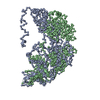
|
|---|---|
| 1 |
|
- 要素
要素
| #1: タンパク質 | 分子量: 80203.047 Da / 分子数: 2 / 変異: YES / 由来タイプ: 組換発現 / 由来: (組換発現)   構成要素の詳細 | ENGINEERED RESIDUE IN CHAIN A, THR 9 TO ALA ENGINEERED RESIDUE IN CHAIN A, GLU 23 TO LYS ENGINEERED ...ENGINEERED | |
|---|
-実験情報
-実験
| 実験 |
| |||
|---|---|---|---|---|
| EM実験 | 試料の集合状態: PARTICLE / 3次元再構成法: 単粒子再構成法 |
- 試料調製
試料調製
| 構成要素 | 名称: RAT PSD-95 / タイプ: COMPLEX |
|---|---|
| 緩衝液 | 名称: 20MM TRIS/HCL, 5MM DTT, 1MM EDTA, / pH: 7.5 / 詳細: 20MM TRIS/HCL, 5MM DTT, 1MM EDTA, |
| 試料 | 濃度: 1 mg/ml / 包埋: NO / シャドウイング: NO / 染色: YES / 凍結: NO |
| 染色 | タイプ: NEGATIVE / 染色剤: Uranyl Acetate |
| 試料支持 | 詳細: CARBON |
-データ収集
| 顕微鏡 | モデル: FEI TECNAI 10 / 詳細: LOW DOSE | |||||||||||||||||||||||||||||||||||||||
|---|---|---|---|---|---|---|---|---|---|---|---|---|---|---|---|---|---|---|---|---|---|---|---|---|---|---|---|---|---|---|---|---|---|---|---|---|---|---|---|---|
| 電子銃 | 電子線源: TUNGSTEN HAIRPIN / 加速電圧: 100 kV / 照射モード: FLOOD BEAM | |||||||||||||||||||||||||||||||||||||||
| 電子レンズ | モード: BRIGHT FIELD / 倍率(公称値): 43000 X / 最大 デフォーカス(公称値): 2250 nm / 最小 デフォーカス(公称値): 900 nm / Cs: 3.6 mm | |||||||||||||||||||||||||||||||||||||||
| 試料ホルダ | 傾斜角・最大: 0.1 ° / 傾斜角・最小: 0 ° | |||||||||||||||||||||||||||||||||||||||
| 撮影 | フィルム・検出器のモデル: GENERIC FILM | |||||||||||||||||||||||||||||||||||||||
| 画像スキャン | デジタル画像の数: 2 | |||||||||||||||||||||||||||||||||||||||
| 放射波長 | 相対比: 1 | |||||||||||||||||||||||||||||||||||||||
| Soln scatter |
|
- 解析
解析
| EMソフトウェア |
| |||||||||||||||||||||||||||||||||||
|---|---|---|---|---|---|---|---|---|---|---|---|---|---|---|---|---|---|---|---|---|---|---|---|---|---|---|---|---|---|---|---|---|---|---|---|---|
| CTF補正 | 詳細: PARAMETERS DETERMINED USING SCATTERING CURVE | |||||||||||||||||||||||||||||||||||
| 対称性 | 点対称性: C1 (非対称) | |||||||||||||||||||||||||||||||||||
| 3次元再構成 | 解像度: 22.9 Å / 粒子像の数: 7854 / ピクセルサイズ(公称値): 3.667 Å / ピクセルサイズ(実測値): 3.667 Å 詳細: THE COORDINATES DEPOSITED ARE FROM A COMBINED SAXS/EM STUDY. THE DOMAINS IN THE PROTEINS (HIGH RESOLUTION STRUCTURES FROM THE PDB) ARE POSITIONED RELATIVE TO ONE ANOTHER USING A SAXS CURVE, ...詳細: THE COORDINATES DEPOSITED ARE FROM A COMBINED SAXS/EM STUDY. THE DOMAINS IN THE PROTEINS (HIGH RESOLUTION STRUCTURES FROM THE PDB) ARE POSITIONED RELATIVE TO ONE ANOTHER USING A SAXS CURVE, THIS COMPOSITE STRUCTURE IS THEN FITTED INTO AN EM MAP. DOMAINS PROVIDED BY X-RAY, NMR POSITIONED BY BUNCH ( PETOUKHOV, M. V. & SVERGUN, D. I. (2005). GLOBAL RIGID BODY MODELING OF MACROMOLECULAR COMPLEXES AGAINST SMALL- ANGLE SCATTERING DATA. BIOPHYS J 89, 1237-50.) REFINEMENT SUBMISSION BASED ON EXPERIMENTAL DATA FROM EMDB EMD-1761. (DEPOSITION ID: 7384). 対称性のタイプ: POINT | |||||||||||||||||||||||||||||||||||
| 原子モデル構築 | プロトコル: RIGID BODY FIT / 空間: REAL 詳細: METHOD--A MAP WAS GENERATED FROM THE SAXS MODEL COORDINATES AT A RESOLUTION MATCHING THE EXPERIMENTAL MAP. T HIS CALCULATED MAP WAS FITTED INTO THE EXPERIMENTAL MAP BY MAXIMIZING THE CROSS- ...詳細: METHOD--A MAP WAS GENERATED FROM THE SAXS MODEL COORDINATES AT A RESOLUTION MATCHING THE EXPERIMENTAL MAP. T HIS CALCULATED MAP WAS FITTED INTO THE EXPERIMENTAL MAP BY MAXIMIZING THE CROSS-CORRELATION WITH THE EXPERIMENTAL MAP. THE COORDINATES WERE THEN REPLACED IN THE CALCULATED MAP TO GENERATE THE FINAL ENTRY. REFINEMENT PROTOCOL--DOCKED USING CHIMERA | |||||||||||||||||||||||||||||||||||
| 原子モデル構築 |
| |||||||||||||||||||||||||||||||||||
| 精密化 | 最高解像度: 22.9 Å | |||||||||||||||||||||||||||||||||||
| 精密化ステップ | サイクル: LAST / 最高解像度: 22.9 Å
| |||||||||||||||||||||||||||||||||||
| Soln scatter model | 手法: RIGID BODY MODELLING コンフォーマー選択の基準: TWO MAJOR CONFORMERS WERE PRESENT IN THE POOL OF REFINED SAXS MODELS CHAIN A REPRESENTS THE BEST AGREEMENT WITH THE EXPERIMENTAL SAXS DATA (CHI=3.3). CHAIN B IS ...コンフォーマー選択の基準: TWO MAJOR CONFORMERS WERE PRESENT IN THE POOL OF REFINED SAXS MODELS CHAIN A REPRESENTS THE BEST AGREEMENT WITH THE EXPERIMENTAL SAXS DATA (CHI=3.3). CHAIN B IS REPRESENTATIVE OF THE SECOND CONFORMATION (CHI=3.8). 詳細: NUMBER OF TIME FRAMES USED 24 (60S, 4.25M CAMERA), 40(60S, 1M CAMERA). PROTEIN CONCENTRATION 1 MG/ML (4.25M CAMERA) 8 MG/ML (1M CAMERA) Entry fitting list: PROGRAM PRE-BUNCH 1IU0/1QLC/1TP5/1KJW + SEQUENCE DATA Num. of conformers calculated: 20 / Num. of conformers submitted: 2 / Software author list: PETOUKHOV, M. V. & SVERGUN, D. I. / Software list: SASREF7/BUNCH8 |
 ムービー
ムービー コントローラー
コントローラー








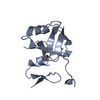
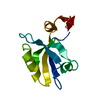
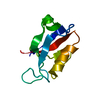

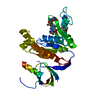
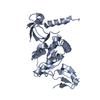
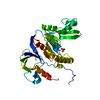
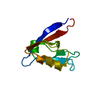
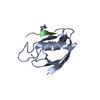
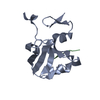

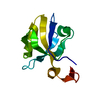
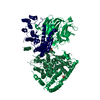
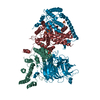
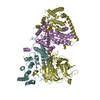
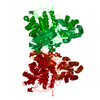
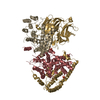
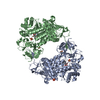
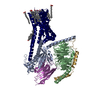
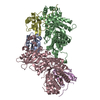
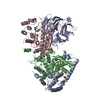

 PDBj
PDBj



